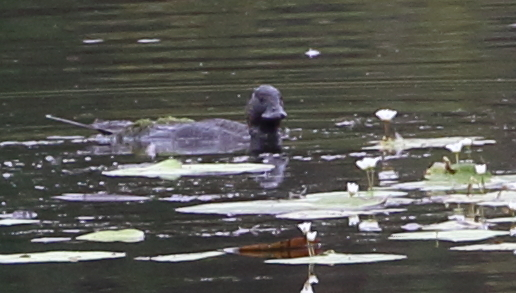Musk Duck Biziura lobata
Category A; Vagrant.

Rare vagrant to Brisbane. May be resident on Moreton Island, but any population once present has probably declined. Not of conservation concern.
| Threat status | Brisbane status |
|---|---|
| IUCN Least Concern | eBird records 95 |
| National Not threatened; Marine | Atlas squares 4 |
| Queensland Not listed | Reporting rate 0% |
Marc Anderson - Dunns Swamp, New South Wales, Australia
One of Australia’s most curious and distinctive species of bird, the Musk Duck is a rare vagrant to Brisbane wetlands. Most records are of single birds in Brisbane, and this species is not particularly gregarious. Further records may come from anywhere there is suitable habitat.
Named for the distinctive odour that breeding males emit (Gray & Fraser 2013), the Musk Duck is one of Australia’s most distinctive endemic species, and is readily identifiable from any other species of waterfowl; the Freckled Duck is superficially similar in its plumage but is structurally very different. Within Brisbane, Musk Ducks are a rare vagrant, with only a handful of records, although some birds have been very long-staying - one individual at Dowse Lagoon was present for over 8 months.
Distribution and Habitat
Musk Ducks have been recorded from several locations around Brisbane, but repeat records are essentially unheard of to date. Interestingly, this species may have at one time been resident or semi-regular on Moreton Island (Vernon & Martin 1975); there are several contemporary records from the island, although more dedicated surveying of the isle’s many small lakes is needed to determine whether or not birds are still regular there or if they have died out.
Seasonality and Breeding
Records of Musk Ducks have come from throughout the year, and it is difficult to confidently ascertain any seasonal trends in the presence of Musk Ducks in Brisbane. Unsurprisingly, birds have never been reported breeding in Brisbane. Further records could conceivably come from any month.
Trends
A vagrant species, there is very little evidence of any long-term trends in this species’ presence in Brisbane. As noted above, this species may have once been regular on Moreton Island and may still be, so some additional dedicated survey effort over on the island would be helpful to determine any long-term trends there.
Information Gaps
- Determine this species’ status on Moreton Island
Key Conservation Needs
- Protect suitable habitat from being drained
- Identify any historic records and protect any remaining populations in Brisbane over on Moreton Island
Contributors to Species Account
Louis Backstrom
References
Gray J & Fraser I (2013) Australian bird names: A complete guide. Csiro Publishing.
Vernon D & Martin J (1975) Birds of moreton island and adjacent waters. Memoirs of the Queensland Museum, 17, 329–33.